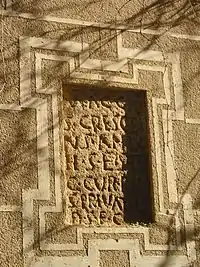Corpus Inscriptionum Latinarum
The Corpus Inscriptionum Latinarum (CIL) is a comprehensive collection of ancient Latin inscriptions. It forms an authoritative source for documenting the surviving epigraphy of classical antiquity. Public and personal inscriptions throw light on all aspects of Roman life and history. The Corpus continues to be updated in new editions and supplements.

CIL also refers to the organization within the Berlin-Brandenburg Academy of Sciences and Humanities responsible for collecting data on and publishing the Latin inscriptions. It was founded in 1853 by Theodor Mommsen and is the first and major organization aiming at a comprehensive survey.
Aim
The CIL collects all Latin inscriptions from the whole territory of the Roman Empire, ordering them geographically and systematically. The earlier volumes collected and published authoritative versions of all inscriptions known at the time—most of these had been previously published in a wide range of publications. The descriptions include images of the original inscription if available, drawings showing the letters in their original size and position, and an interpretation reconstructing abbreviations and missing words, along with discussion of issues and problems. The language of the CIL is Latin.
Beginnings
In 1847 a committee was created in Berlin with the aim of publishing an organized collection of Latin inscriptions, which had previously been described piecemeal by hundreds of scholars over the preceding centuries. The leading figure of this committee was Theodor Mommsen (who wrote several of the volumes covering Italy).[1] Much of the work involved personal inspections of sites and monuments in an attempt to replicate the original as much as possible. In those cases where a previously cited inscription could no longer be found, the authors tried to get an accurate reading by comparing the versions of the published inscription in the works of previous authors who had seen the original. The first volume appeared in 1853.
Current status
The CIL presently consists of 17 volumes in about 70 parts, recording approximately 180,000 inscriptions. Thirteen supplementary volumes have plates and special indices.[1] The first volume, in two sections, covered the oldest inscriptions, to the end of the Roman Republic; volumes II to XIV are divided geographically, according to the regions where the inscriptions were found. The other volumes cover other topics. Volume XVII, for instance, is entirely devoted to milestones. A volume XVIII is planned, which will contain the Carmina Latina Epigraphica (Latin verse inscriptions). A two-volume "Index of Numbers", correlating inscription numbers with volume numbers, was published in 2003.[2]
The Berlin-Brandenburg Academy of Sciences and Humanities (BBAW) continues to update and reprint the CIL.
Index
List of volume with the date of first publication.[3]
- Vol. I: Inscriptiones Latinae antiquissimae ad C. Caesaris mortem (1893)
- Vol. II: Inscriptiones Hispaniae Latinae (1892)
- Vol. III: Inscriptiones Asiae, provinciarum Europae Graecarum, Illyrici Latinae (1873)
- Vol. IV: Inscriptiones parietariae Pompeianae, Herculanenses Stabianae (1871)
- Vol. V: Inscriptiones Galliae Cisalpinae Latinae (1872)
- Vol. VI: Inscriptiones Urbis Romae Latinae (1876)
- Vol. VII: Inscriptiones Britanniae Latinae (1873)
- Vol. VIII: Inscriptiones Africae Latinae (1881)
- Vol. IX: Inscriptiones Calabriae, Apuliae, Samnii, Sabinorum, Piceni Latinae (1883)
- Vol. X: Inscriptiones Bruttiorum, Lucaniae, Campaniae, Siciliae, Sardiniae Latinae (1883)
- Vol. XI: Inscriptiones Aemiliae, Etruriae, Umbriae Latinae (1888)
- Vol. XII: Inscriptiones Galliae Narbonensis Latinae (1888)
- Vol. XIII: Inscriptiones trium Galliarum et Germaniarum Latinae (1899)
- Vol. XIV: Inscriptiones Latii veteris Latinae (1887)
- Vol. XV: Inscriptiones Urbis Romae Latinae. Instrumentum domesticum (1891)
- Vol. XVI: Diplomata militaria (1936)
- Vol. XVII: Miliaria Imperii Romani (1986)
See also
References
- See the CIL site under External links below.
- Fassbender, Andreas, ed. (2003). Index Numerorum. CIL Auctarium Series Nova. Erster Band, Zweiter Band. ISBN 3-11-017936-9.
- Cébeillac-Gervasoni, Caldelli & Zevi 2006, pp. 30–33.
Bibliography
- Cébeillac-Gervasoni, Mireille; Caldelli, Maria Letizia; Zevi, Fausto (2006). Épigraphie latine. Armand Colin. ISBN 2-200-21774-9. OCLC 470566532.
External links
| Wikimedia Commons has media related to Corpus Inscriptionum Latinarum. |
- "Corpus Inscriptionum Latinarum". Berlin-Brandenburg Academy of Sciences and Humanities. Retrieved 13 November 2009.
- "CIL volumes". Berlin-Brandenburg Academy of Sciences and Humanities. Retrieved 19 December 2009.
- "English translations of selected inscriptions from CIL". attalus.org. Retrieved 8 October 2012.
- Arachne CIL Open Access Project Retrieved 25 January 2021.